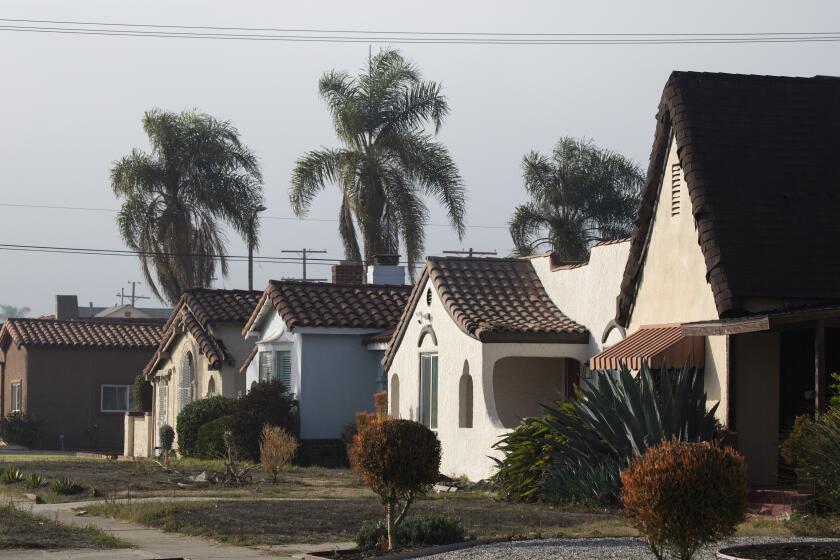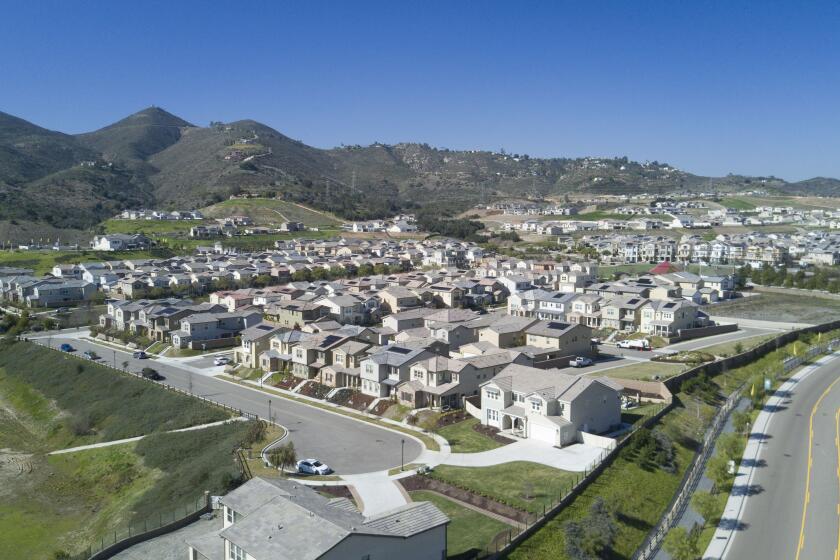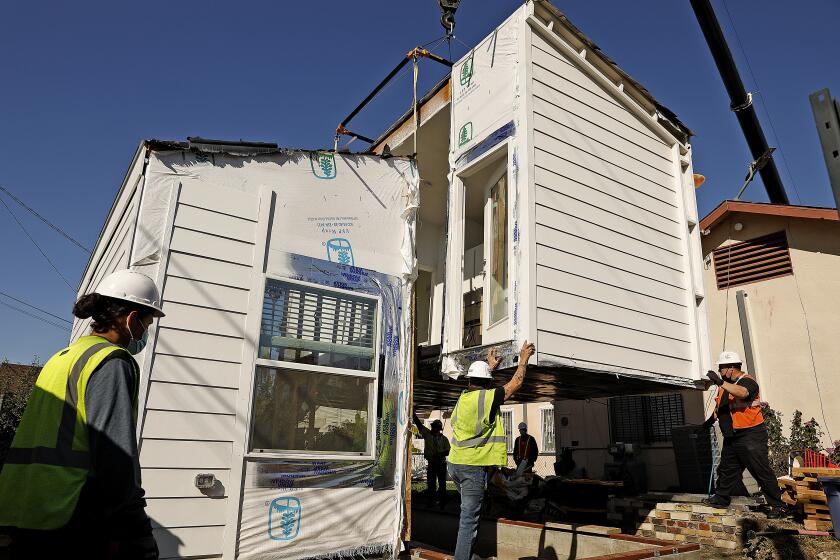
- Share via
A cadre of Silicon Valley elites is drawing fierce criticism from local residents and environmentalists for planning a new city on the outskirts of the Bay Area, a project dubbed “California Forever.” But the effort should be applauded for revealing a truth about California’s failed housing policies.
This group of California’s most influential wants to build one or more new towns on the urban fringes, having spent about $900 million to buy an area roughly twice the size of San Francisco some 60 miles east of the city. The project breaks with the philosophy of the state’s housing policy, which has long been focused on urban densification.
Despite the state’s efforts to encourage residential development, California’s housing markets remain among the least affordable in the country. The homeownership rate is near the nation’s lowest. To afford a house at the median price today in Southern California, a family needs an annual income of $180,000, twice the region’s median.
California’s median home price is near $750,000. The most promising prescription for the housing shortage is undoing single-family zoning and increasing density.
Some housing advocates insist that the solution is to force growth into existing neighborhoods. Yet the state’s supposedly pro-development new housing laws have yet to produce more homes at a scale sufficient to address the affordability crisis, and recent data suggest an accelerating decline in housing production.
Over the last five years, California has consistently lagged in construction not just of single-family housing but of multifamily housing as well. Not one California metropolitan area was among the top 50 in housing growth last year; Texas had six areas on that list, Florida 11. Los Angeles, the state’s dominant metropolitan area, didn’t crack the top 200.
Clearly we need a new approach that is more aligned with market demands. A recent report by London Moeder, a San Diego real estate consultancy, noted that California regulations make it difficult to build the kinds of housing people are looking for, particularly multi-bedroom homes that can accommodate families.
Research by Jessica Trounstine at UC Merced similarly found that “preferences for single-family development are ubiquitous. Across every demographic subgroup analyzed, respondents preferred single-family home developments by a wide margin. Relative to single-family homes, apartments are viewed as decreasing property values, increasing crime rates, lowering school quality, increasing traffic and decreasing desirability.”
L.A., San Francisco and other cities need massive private development to supply homes and reduce homelessness. That’s why reforms like SB 9 fail.
Opposition to densification of existing neighborhoods remains staunch in many cities, with some threatening a voter initiative to restore municipal control of zoning.
California’s focus on increasing density in urban areas is also at odds with the national shift toward remote work and retail and office growth in more suburban, lower-density areas.
A sensible California housing policy would respond to these trends and consumer desires, much as the Bay Area project promises to do. This does not mean we will need sprawling growth.
California’s population is dropping and is not expected to increase in the next four decades, which alters projections of future housing needs. The solution lies in strategic growth. Rather than force growth in places that are declining in population and resistant to development, including Los Angeles County and San Francisco, the state needs to look at the parts of California that are growing, places such as Riverside and Yolo counties.
The state still suffers from high rents and a disproportionate homeless population. But there are signs of progress in Los Angeles, San Diego and other cities.
To encourage growth where it’s happening naturally, the state could create a “Housing Opportunity Area” comprising the Central Valley and Inland Empire, subject to more liberal rules than the coast. Land costs are far lower in the interior of the state than in metropolitan Los Angeles, San Francisco, San Diego and San José. Policies that support inland development could help stem the outbound migration of Californians.
The rise of remote work means development away from urban centers is far more plausible and less environmentally toxic than in the past. Indeed, the International Energy Agency suggests that if everybody able to work from home worldwide were to do so just one day a week, it would save around 1% of global oil consumption for road transport per year. That would prevent 24 million metric tons of annual carbon dioxide pollution, equivalent to the bulk of greater London’s emissions. And roughly 40% of California’s jobs, including 70% of its higher-paying ones, could be done at home, according to research by the California Center for Jobs and the Economy.
Equally promising, many new suburbs are being designed in consciously more sustainable ways, as MIT professor Alan Berger suggests. Sophisticated systems for controlling energy and water use can make suburban and exurban communities more environmentally responsible. Another promising innovation is broader use of manufactured housing, which has the potential to speed construction by as much as 50%, according to a 2019 McKinsey & Co. report. A single-family subdivision is under construction by 3-D printer in suburban Austin.
There are still opportunities for innovative housing production in dense urban cores such as downtown San Francisco and Manhattan. New York Mayor Eric Adams is seeking to quickly add 20,000 housing units through office building conversions. He has also proposed a larger program to convert more than 130 million square feet of office space to residential use, though he needs state legislation to reach that goal.
Yes, Southern California needs more housing density, but we can put our sprawl to use without ditching our spacious vibe.
More such promising opportunities may lie in old, underused retail spaces in both cities and suburbs, which have the advantage of simple floor plans, ample parking and presence across metropolitan California. A recently announced plan to replace Buena Park’s vacant Sears building with 1,100 housing units could represent one piece of our housing future. Flagging malls in Orange County and throughout California provide similar possibilities.
Such developments are critical to our increasingly diverse middle and working class. Older, overwhelmingly white Californians have achieved high rates of homeownership, but the rates among millennials, African Americans and Latinos are well below the national average.
If they don’t leave the state entirely, younger generations will tend to continue to migrate outward in search of affordable suburbs. The majority of people of color in California live in suburbs, accounting for virtually all suburban growth over the past decade. Communities could be built in the exurbs and beyond for senior citizens, too, helping to produce new housing opportunities for young families near job centers. The outer suburbs and exurbs are the future homes of most Californians.
We have the land for such a new vision. While other populous states have devoted as much as a third of their land to urban development, California’s developed lands constitute only 6% of the state. A “7% solution” to the California housing crisis would free up 1 million more acres to build the new communities that we largely stopped building around 2000, when we had 5 million fewer people.
Relying on billionaires to build new cities in the hinterlands isn’t a generally sustainable answer to California’s housing crisis. But the California Forever project does rightly suggest that our solutions must build on the state’s penchant for innovation, capitalism and a distinctly suburban lifestyle.
Joel Kotkin is the presidential fellow in urban futures at Chapman University. Wendell Cox is the principal of Demographia, a public policy consulting firm.
More to Read
A cure for the common opinion
Get thought-provoking perspectives with our weekly newsletter.
You may occasionally receive promotional content from the Los Angeles Times.













